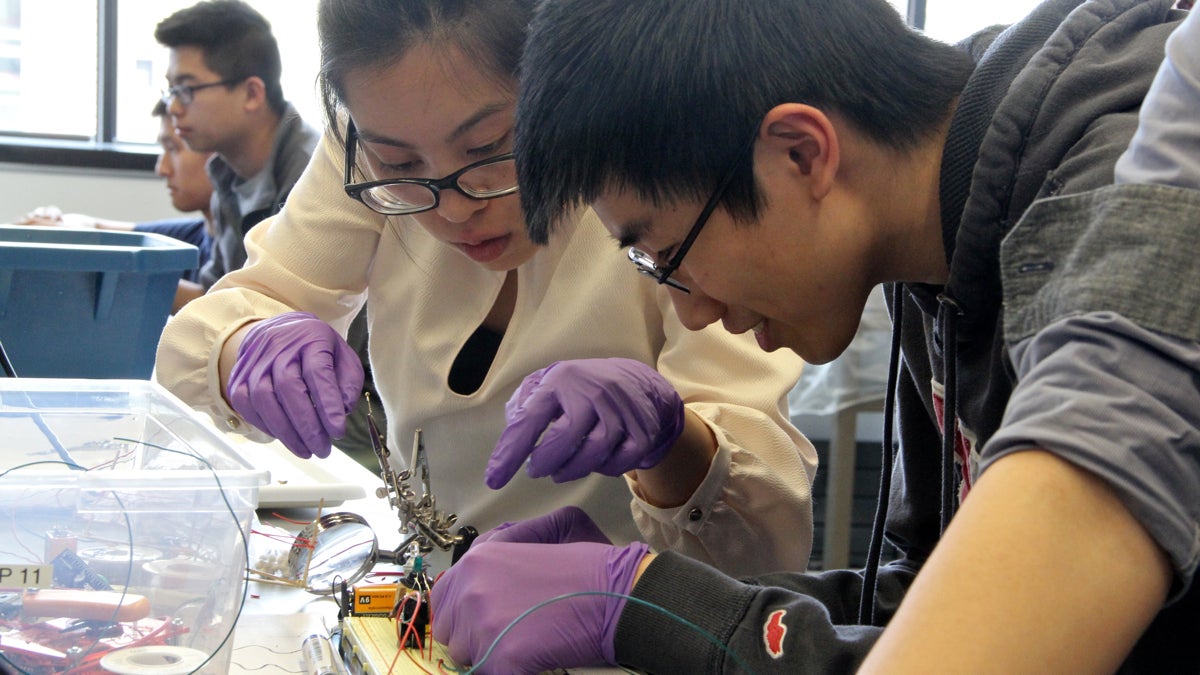Rock ‘Em Sock ‘Em … cockroach style?
Listen
Stephanie Mark and her lab mate maneuvering the severed cockroach leg into position. (Emma Lee/WHYY)
Severed cockroach legs serve as training tool for next generation of engineers working on artificial limbs.
Four University of Pennsylvania juniors crowd around a pair of severed cockroach legs. Steve Rybicki blinks aggressively, while his teammates stare wide-eyed at their creation.
“Our project is dealing with EEG and EMG signals,” Rybicki explains. “And so I have electrodes connected to my head, and based on different actions that I do–whether I am keeping my eyes closed or open or blinking my eyes–it generates different signals.”
Those electrical signals run into a computer, where software translates them into stimuli, which pass down wires connected to the specimens. Steve blinks…the cockroach legs wiggle.
One workbench over, another team of engineers hum into a microphone, the notes causing the legs to move in different directions.
The Frankenstein-feel to this laboratory perhaps masks the hard science of the assignment: students are learning the technologies shaping the next generation of artificial limbs.
“We’re trying to make the leg respond in a timely fashion for a purpose, which would be done for human prosthetics,” says Arianna Schanzer.
Cockroaches work as decent guinea pigs because the relatively simple neuromuscular structure in their leg stays active for roughly 45 minutes following amputation.
“We wanted to pick kind of the lowest phylogenetic species possible, and still get motor function,” says Professor Shauna Dorsey. “That’s why we selected cockroaches, and this breed of cockroach is pretty unique in that its body weight is so heavy that it—I think it does have wings—it doesn’t fly, so it relieves some of the anxiety of the students.”
When Stephanie Mark’s team is in need of a new leg, she casually plucks a cockroach from its cage, then submerges it in a bucket of shaved ice.
“If you poke them and they don’t move, then we figure they are pretty much anesthetized,” she explains.
Using tweezers and a scalpel, she takes the limb.
“So what we do is lift the leg up and then try to snip it off as close to the body as possible,” Mark explains. “We try to work as quickly as we can, so the cockroach doesn’t come out of its little anesthetized state.”
Cockroaches have six legs. This one now has five. Once down to four, it’s considered too disfigured to live a meaningful life, and will get put in a ziplock bag and moved to the freezer, where it’s time comes to an end.
Compared to getting stepped on or hit with a rolled up magazine, it seems relatively humane.
The class did go over the ethical issues involved with animal research studies, according to Vahid Hoshmand.
“We had a discussion on cockroaches as a species. They don’t really feel, so they don’t realize they are feeling pain,” Hoshmand says. “They may just think something is off, but that’s about it. So, I’m pretty okay with it, actually.”
Some of today’s most advanced prostheses aim to extend the signals that travel from the brain down into the artificial limb. Vivek Menon’s group is working on something similar, though simplified.
“I think we are one of the few groups that are actually trying to integrate actual physiological signals,” says Menon. “Like, we have electrodes to the arm, and processing it, and then also outputting it on the cockroach. So it is a little bit complex. On the other hand, it probably won’t work quite as beautifully as the other projects.”
For beauty alone, Brian Tong and his crew win the award.
“We are making Rock ‘Em Sock ‘Em Cockroach legs. And basically, what happens is, if you’ve ever played Rock ‘Em Sock ‘Em Robots, you got two guys trying to punch each other out, and instead of arms, we have cockroach legs,” says Tong.
They’ve even made a little boxing ring. Lego-men with legs-for-arms square off like Pacquiao and Mayweather, the appendages throwing jabs when the students manipulate a handheld accelerometer.
It has little to do with real life, but it’s funny, and that seems to count.
“We stress the fundamentals, and I fear that we stifle creativity,” says David Meany, Chair of Bioengineering at UPenn. “And that’s one of the things that we try to stress, because I think if we are going to educate engineers, we also need to educate creativity in some way, and this helps them with that.”
Meany says the plan for next year is a competition, with students voting for their favorites.
The next generation of bio-medical devices, conceived one tiny leg at a time.
WHYY is your source for fact-based, in-depth journalism and information. As a nonprofit organization, we rely on financial support from readers like you. Please give today.



